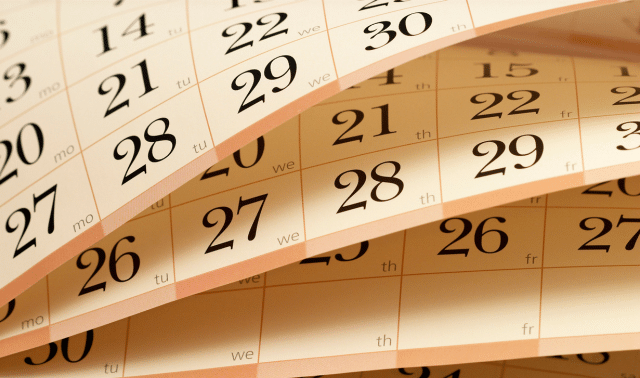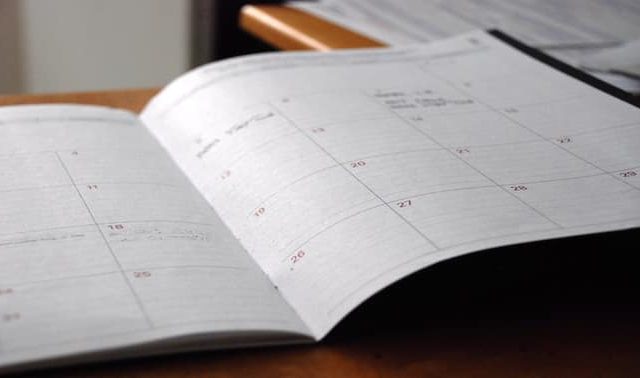Sign up for the Family Tree Newsletter Plus, you’ll receive our 10 Essential Genealogy Research Forms PDF as a special thank you!
Get Your Free Genealogy Forms
"*" indicates required fields
Serious genealogists recognize that they are never truly “done” when it comes to chasing down leads for their ancestors. However, while researching your roots, do you often feel frustrated by tedious tasks or research roadblocks?
To help you combat them—and to make the most of the new year—we’ve mapped out a day-by-day research plan. (2024 is a leap year, meaning you get an extra day of genealogy!)
If you’d prefer to think of the year month by month, check out Sunny Jane Morton’s monthly research plan. We also have guides for one-month, one-week and one-day research plans, plus tasks for your lunch breaks or weekends.
ADVERTISEMENT
Genealogy Tasks By Month
JANUARY | FEBRUARY | MARCH |APRIL | MAY | JUNE | JULY | AUGUST | SEPTEMBER | OCTOBER | NOVEMBER | DECEMBER
January
See also: Family History Projects for January
- In recognition of Copyright Law Day, explore the basics of US copyright law.
- Identify your genealogy goals for the year, and make a concrete research plan.
- Take an inventory of your supplies and research materials. List what you still need.
- Spent too much on holiday gifts? Evaluate your genealogy budget for the year. Consider how to get more out of free resources, including trials at subscription websites.
- Take a trip to an office-supply store or browse online to stock up on file folders, notepads, pencils, USB drives—whatever’s on your supply list.
- Get involved in your local community. Find a senior citizens center, Rotary Club, library, or historical society, and see if you can volunteer or organize a family history workshop.
- Some Orthodox Christian churches continue to use the Julian calendar, and celebrate Christmas today. Learn how to convert between the Julian and Gregorian calendars.
- Create a backup system for your research that uses the 3-2-1 principle: three different copies on two different media, with at least one of them backed up offsite (such as in the cloud).
- Review family history notes from your conversations with relatives, and add new information to your software and/or charts.
- Most 1890 US census records were destroyed 103 years ago today. See what parts survived.
- Transfer digital photos from your devices to your computer and/or your cloud storage account.
- Start a research log or journal. The free online tool Trello can track your tasks in lists and cards.
- File any loose documents in your family history binder or file folders.
- Make an index of what’s in each file folder or binder and post it on their covers. Create a master index that includes all your files, too.
- This Martin Luther King Jr. Day, find out how your family may have been involved in civil rights movements. Start at the National Civil Rights Museum.
- Download indexes for all 20-plus years of Family Tree here.
- Make a list of vital records you need. Check each state office’s website for record locations, fees and forms.
- Use holiday cards and family newsletters to update your relatives’ contact information. Make sure everyone knows how to reach you, too.
- Call your local public library or state archive and arrange a tour of the genealogy department. Look for special collections, especially those that aren’t digitized.
- Create a genealogy correspondence log in an Excel spreadsheet. List letters you send and receive alongside contact information.
- Fill out the vital-record request forms you collected on the 17th. Record the requests in your correspondence log.
- Decide how you’ll include online keyword searches in your research log.
- Celebrate National Handwriting Day by trying to decipher script in hard-to-read records. Get tips here.
- Consult Cyndi’s List to find message boards related to your ancestral surnames and places of residence.
- Find your nearest FamilySearch Center or partnering library. Run a Google search, or visit FamilySearch’s website.
- Brainstorm ideas for a genealogy blog, and research possible platforms. Check GeneaBloggers for tips and inspiration.
- Today is Holocaust Remembrance Day. Learn more.
- Organize your genealogy periodicals, including electronic versions. Give extra print copies to a friend or library.
- Make your own family history trivia game with the tips here.
- Start a family history album that includes photographs and copies of family documents. Get inspiration here.
- The first month of the year has flown by! Review your genealogy progress, then put up your feet and relax.
February
See also: Family History Projects for February
ADVERTISEMENT
- Kick off Black History Month by picking up Alex Haley’s seminal novel Roots, or watch the TV miniseries based on it.
- Feeling in a rut, like Bill Murray in “Groundhog Day”? Save yourself from running the same ancestor searches over and over again by consulting your research log.
- Start a biographical outline for each person you’re researching. Download our free template.
- Continue yesterday’s biography project. It’s a big job!
- Purchase archiving essentials such as photo-storage boxes and an archival-safe pencil from a supplier such as Gaylord.
- Create a travel-friendly research binder that includes: copies of your charts; your to-do list; a list of alternate spellings for surnames and places; and blank pages for note-taking.
- Today is Safer Internet Day. Consider changing your passwords, and install any updates to your apps, browsers and virus-protection program.
- Create timelines for an ancestral family to place it in historical context. Use your genealogy software, or try Timetoast or Genelines.
- Move your photographs to the storage boxes you bought earlier this month. Try to sort them chronologically, and label backs with names and dates.
- With today’s Lunar New Year, the Year of the Dragon begins. What signs are associated with your ancestors’ birth years?
- Write a character sketch about your favorite ancestor, as if they were in a film or novel.
- Today is Abraham Lincoln’s birthday. See his family tree (and the trees of other famous people) at WikiTree.
- Study the FAQ or tips page at your favorite genealogy website to power up your searches. Then, try the advice there!
- Happy Valentine’s Day! Write the story of how your favorite ancestral couple (or you and your partner) met.
- A new episode of the free Family Tree Magazine Podcast debuts today.
- Gather your research materials and visit your nearest FamilySearch Center or partnering library.
- Determine spelling variations for the name of an ancestral hometown. Also study any border or jurisdictional changes it’s had throughout history.
- Review our list of the best websites for African American genealogy research.
- Post offices are closed for Presidents’ Day. But you can still check your online family tree accounts for messages!
- Search for genealogy-related titles on Google Books, and set up your virtual library.
- Start scanning stray ancestral photographs. Use your smartphone or a desktop scanner.
- George Washington is honored today. This founding father didn’t have biological children, but you might still be related to him. See his family tree from Mount Vernon’s website.
- Learn how to add scanned photos (as well as any metadata) to your genealogy software and/or online tree.
- Start organizing a family gathering, such as a reunion. Contact relatives who can help, or the relative who’s run events in the past.
- Share ancestral photographs with a relative who may have new information about them.
- Start a digital scrapbook by collecting files and photos. You can publish using social media, scrapbooking software, or a book-printing service.
- Is your genealogy software working for you? Check the manufacturer’s website for upgrades, or try a different program.
- RootsTech 2024 is about to begin in Salt Lake City. Make sure you’re registered to watch virtual presentations. Follow along here.
- Leap Day—enjoy an extra day of genealogy! Chase down research BSOs (bright shiny objects), such as record hints from Ancestry.com or MyHeritage.
March
See also: Family History Projects for March
- During Women’s History Month, visit this website for free resources.
- Download or print the Fearless Females Blogging Prompts to start writing about a favorite female ancestor.
- Print ancestor charts and family group sheets for the women in your family tree. Make plans for finding missing facts.
- List all your female ancestors’ maiden names (or as many as you can), then search for them in online collections.
- Record the results of yesterday’s searches in your research log/genealogy software. Make sure women are listed by their maiden names.
- Ditch the electronic devices to take a walk with a relative, friend, or pet (or just by yourself)!
- Use photo-identification tips from the Photo Detective to investigate a mystery photo of a woman in your family.
- What’ll happen to your research when you’re gone? Arrange to leave it to a relative or a historical society. Consider creating a “genealogy will.”
- Look up your ancestral addresses in city directories, which you can find at Ancestry.com, MyHeritage, and library websites.
- Don’t let losing an hour to Daylight Saving Time set you back. Catch up on your genealogy (paper or electronic) filing today.
- Enhance a female ancestor’s timeline with social history events related to women’s rights, such as the adoption of the 19th Amendment (1920).
- Wish you could visit your ancestral homeland or take a genealogy cruise? Daydream by visiting your target country’s tourism website or Genealogy Cruises.
- Check out ConferenceKeeper for spring and summer genealogy conferences.
- Pick an ancestral state and explore its state archives or library website. Keep an eye out for county histories, research tips, and record collections and indexes.
- Beware the Ides of March! The Romans honored it by settling debts—do the same by checking the expiration dates for your paid genealogy subscriptions.
- Tap into Family Tree’s collection of articles on finding female relatives.
- Celebrate St. Patrick’s Day by visiting RootsIreland and the National Archives website.
- Explore the Women’s History Month portal, a collaboration between the Library of Congress and related organizations.
- The windows can wait—spring-clean your genealogy research instead. Sort your papers, file emails, and tidy your computer desktop.
- Get familiar with your local library’s online finding aid or catalog.
- Grab your research binder and visit the library to find the resources you saw yesterday.
- Home sources can be fonts of information, especially about female ancestors. Look in your attic (or contact relatives) for diaries, wedding-guest registers, baby books, family Bibles, letters, and more.
- Seek historical photos and postcards from your ancestors’ time. Check auction sites such as eBay and photo-reunion sites such as DeadFred and AncientFaces.
- Try out the photo-editing, -colorization and -animation tools at MyHeritage, which you can use for free on a limited number of photos. A subscription offers unlimited uses.
- Use Chronicling America to search over 20 million historical newspapers from around the United States.
- Choose your favorite female ancestor and jot down some stories about her.
- Page through cookbooks you’ve inherited and ask your relatives to do the same. You might discover handwritten recipes and notes.
- Run searches at your favorite genealogy websites—even if you’ve already done so this year. New records may have been added or indexed.
- Easter is this weekend! Get hopping to learn more about your favorite family traditions.
- Did you inherit Grandma’s china or wedding ring? Catalog your family heirlooms with a free trial of Artifcts.
- Back up your family tree data, and print updated research logs and charts.
April
See also: Family History Projects for April
- Celebrate April Fools’ Day by writing down a funny family story or Grandpa’s corniest joke.
- The 1950 US census was released to the public two years ago today. Search it (and other censuses) for free at FamilySearch.
- Research DNA testing options ahead of DNA Day later this month. These reviews can help.
- Collect five to ten family history questions to ask a relative. Call or email to set up a time to talk.
- Do you have an image of an unknown object or place? Try a search using Google Lens.
- Search for images of your ancestors’ gravestone at Find a Grave or Interment.net.
- April showers bring May flowers—and a chance to catch up on genealogy TV shows like “Finding Your Roots” (PBS) and “Relative Race” (BYUtv).
- Browse the website of local genealogical or historical societies. Look for resources such as classes, webinars, publications and records, and consider attending a meeting.
- File any stray digital photos that are on your hard drive or desktop.
- It’s Siblings Day. Double-check your software or online tree for missing data about your ancestor’s brothers or sisters.
- Review your list of DNA matches for new possible relatives. New people are taking DNA tests all the time!
- The Civil War began at Fort Sumter 163 years ago. Search the Civil War Soldiers and Sailors Database.
- Make sure you’re subscribed to Family Tree’s free email newsletter for genealogy news and research tips. You’ll get some great downloads too!
- Let’s hope your tax return is well on its way to Uncle Sam! Your ancestors’ tax records make good substitutes for missing censuses. Use the links at Cyndi’s List to start searching.
- The Titanic sunk in the early hours of 15 April 1912. Research this shipwreck and others at The Ships List.
- You’re perfectly law-abiding, of course, but an ancestor may have done some jail time. Get hints on researching court and institutional records at Blacksheep Ancestors.
- Observe Ellis Island Family History Day by searching for immigrant ancestors through the Statue of Liberty—Ellis Island Foundation.
- A major earthquake struck San Francisco on this day in 1906. Peruse historical newspapers to find out more about this and other disasters your ancestors lived through.
- Not successful with your Ellis Island searches so far? Try the Ellis Island Search Forms on One-Step Webpages.
- Thank the volunteers at your local genealogical or historical society. (Better yet, why not volunteer yourself?)
- Go back to the One-Step Webpages site to explore tools for immigration databases, the Social Security Death Index, vital-records indexes and more.
- Celebrate Earth Day by finding ways to cut back on paper in your research.
- Time to create or review your genealogy reading list. Library Thing is a great app for this task.
- See what research tips and digital images the University of Minnesota’s Immigration History Research Center has for you.
- For National DNA Day, scour the major testing companies’ websites for sales on testing kits.
- Note your brick walls. Writing them down can help you think through steps for smashing them to bits.
- Consider talking to family friends or neighbors. Or write down your own reflections about a favorite family member.
- Organize any printed obituaries and funeral cards in your collection. Sort them by family, alphabetize them, and place them in clear sheet protectors.
- Share your discoveries. Have you identified a mystery photo, or found your great-great-grandfather’s military record? Send a copy to a relative.
- As Passover ends today at sunset, explore the excellent Jewish genealogy databases and resources at JewishGen.
May
See also: Family History Projects for May
- Happy May Day, the point roughly halfway between the first day of spring and the summer solstice. Review the goals you set in January, and what progress you’ve made.
- Maybe your ancestor isn’t in US passenger lists because he first immigrated to Canada. Look for information on border-crossing records.
- Join the hundreds of thousands of worldwide volunteers on BillionGraves, and head to your local cemetery to snap and upload cemetery pics.
- Horse-racing fans flock to Churchill Downs today for the 150th Kentucky Derby. Find state-specific genealogy resources here.
- Celebrate both Cinco de Mayo and Orthodox Easter by studying FamilySearch’s Mexican and Orthodox records.
- Explore the digital collections on Yad Vashem—The World Holocaust Remembrance Center.
- Purchase an orphaned family Bible or photo from a flea market and track down its rightful owner using websites such as DeadFred.
- Check libraries and historical societies for ancestral town anniversary booklets or newspaper accounts of centennial celebrations.
- Try FamilySearch or the local coroner’s office for coroner’s records, which may contain clues to an ancestor’s untimely death.
- Prepare for a research trip to the courthouse. Call or look online to check record holdings, hours and visitor regulations. List records you want to find.
- For “Eat What You Want Day,” whip up a favorite family recipe.
- This Mother’s Day, research your maternal lines. (And call the moms in your life!)
- Search eBay for genealogy plus your family surnames and places.
- Brainstorm clubs, fraternal organizations or trade associations your ancestors may have belonged to. Then check Cyndi’s List.
- Celebrate International Day of Families today by noting the social, economic and demographic issues that impacted your ancestors.
- The National Genealogical Society’s annual conference is about to begin. Consider signing up for the all-virtual event.
- Norway celebrates Constitution Day today. Explore the holdings of the country’s digital archives.
- Explore a museum in your local area, or Google virtual museums to explore one from your easy chair.
- Clean up your computer hard drive with software such as Clooz and PaperPort.
- Update your blog, or see what’s new at GeneaBloggers.
- Search for your forebears’ death records using Joe Beine’s directory.
- Seek out records from your ancestors’ funeral homes. Find the name of the funeral home in obituaries and death certificates, then contact the home or look for their records in historical societies and libraries.
- Repair faded photographs and documents with a free trial of the Vivid-Pix RESTORE software.
- Research “sideways” by looking for collateral relatives: for example, an ancestor’s brother.
- Records of city, county or town councils can lead to business licenses, petitions or minutes that bear your ancestor’s name. Look for them at public libraries or municipal or state archives.
- Look for postcards showing your ancestors or their favorite places, both in your own collection and at sites like Ancestry.com.
- This Memorial Day, visit the grave of a family member who served in the military. You could go either in person or virtually through sites like Find a Grave and Fold3.
- Have old videotapes or films that you’d like to digitize? Try a service such as Larsen Digital.
- Occupational directories—listings of local people in a particular profession—may give you clues to relatives’ daily lives. Look for them online and at your library or historical society.
- Tap into your creative muse and start a family history project, such as a genealogy quilt or a poem about an ancestor.
- See what web listings are available for your surnames and ancestral locations at Linkpendium.
June
See also: Family History Projects for June
- The 1931 census of Canada was released to the public one year ago today. Have you checked it for your ancestors? Read Family Tree‘s guide.
- Schools may be out for summer, but you can still find your ancestor’s yearbook at sites such as Classmates.com, Ancestry.com and MyHeritage.
- Have a relaxing reading session at the beach, a local park, or your own backyard.
- Consult your timelines to see when ancestors graduated high school and college. Study historical newspapers for announcements and exam-passing lists.
- The first of three US WWI draft registrations took place on this date in 1917. Search for registration cards at FamilySearch.
- The Allies stormed the beaches of Normandy on this day in 1944. Learn more about D-Day (and World War II generally) through the National WWII Museum.
- Celebrate your roots at a church’s or social club’s ethnic festival.
- For National Best Friend Day, write a biography of one of your ancestor’s best friends (or of your own buddy).
- A pack-rat ancestor may have left an envelope or shoebox stuffed with old receipts for purchases, bills and bank deposits. Track it down, then decide what is and isn’t worth keeping.
- Look for wills and estate papers among court documents. You may find bequests to friends, relatives or neighbors, as well as names of debtors and outstanding bills.
- Sketch out a plan (“storyboard”) for a family history video. Look for photos, sound clips, scanned documents, and videos to include.
- Tap into the (mostly) free DNA Painter to demystify your test results with color-coded family trees, chromosome-mapping, and relationship calculators. Watch a tutorial here.
- Got ancestors who lived in orphanages? Start tracking them using the links at Cyndi’s List.
- Investigate immigrant ancestors’ naturalization records in honor of Flag Day.
- Study relatives’ hobbies, favorite hangouts, and social clubs by examining souvenirs, trophies, ribbons, pins and related memorabilia.
- Observe Father’s Day by focusing on your paternal lines. And don’t forget to call the dads in your life!
- Page through old address books for names of past generations’ friends and neighbors. Then look up their surnames in a modern telephone book or on social media to see if you can find descendants.
- Examine historical maps of ancestral locales. Then see if you can pinpoint where relatives lived, worked and attended church.
- Juneteenth commemorates emancipation in Texas. Here are six digital record projects that will help you trace enslaved ancestors.
- Review Sanborn fire-insurance maps, which can give you detailed descriptions of family homes.
- Smile for the camera—it’s National Selfie Day! Take a good one and post to your favorite social media platform for future generations.
- Check out the tips and resources at Reunions magazine if you help plan the annual family reunion.
- Use NARA’s Access to Archival Databases to search WWII Army enlistments, Korean and Vietnam War deaths, and other records.
- Add metadata to your images to describe what the file is, when/where it was taken, and how it’s been modified. Select a few photos to start.
- Share an ancestral photo to your favorite social media site.
- Use a relationship calculator or chart (you’ll find both at here) to figure out how you’re related to an internet cousin.
- For National Bingo Day, create a fun ancestral bingo game to play at your next family gathering or reunion. See a template.
- The assassination of Austria’s Franz Ferdinand on this day in 1914 triggered World War I. View an interactive timeline.
- Turn your research upside down and print out a descendant tree chart from your genealogical software program. Note gaps to fill in.
- You’re about halfway through the year. Update and reprioritize your to-do lists and review your research logs.
July
See also: Family History Projects for July
- For Canada Day, see what resources are online through the Library and Archives Canada.
- Learn about the US naturalization process here.
- See how lineage societies such as the Daughters of the American Revolution can help with your research.
- Research your Revolutionary War ancestors with Family Tree‘s resources.
- Pay tribute to your Czech roots by listening to a polka tune, or drink a cappuccino in honor of your Italian kin.
- Attend summer school at Family Tree University.
- Still looking for your immigrant ancestors? Search the special projects collections through the Immigrant Ships Transcriber Guild.
- Apply the “Six Degrees of Kevin Bacon” game to your ancestry. Try to connect yourself to relatives in as few links as possible.
- Consider uploading your DNA test results to another service or website. This will open you to new pools of possible matches.
- Review the Western States Historical Marriage Record Index for reference to your pioneer kin.
- For World Population Day, hone your international research skills by perusing records from an ancestral country. The FamilySearch Wiki has guides to help you start.
- Confused by a word in a record? Look up old medical terms.
- Sign up for a free trial of WeAre.xyz to share collections, diaries, documents, photos, videos and more.
- Clear your mind from genealogy clutter. Do something completely unrelated to family history today: Go for a walk, ride a bike or see a movie.
- Your genealogy break was nice. Now get back to research by tackling a brick-wall ancestor with fresh eyes.
- Organize the bookmarks in your web browser.
- Put on your detective hat, get out your magnifying glass and take a closer look at family documents and photographs for clues you may have missed.
- Have fun with family history. Turn a photo into a jigsaw puzzle using a kit from a craft store or an online printing service.
- Consider hiring a professional researcher. Search the Association of Professional Genealogists directory.
- Think you have famous folks in your family? Take a gander at the celebrity family trees at Geneastar. Sign up to the site to compare your own tree.
- Say what? Decode archaic terms in records or correspondence with this dictionary.
- Consult the FamilySearch Wiki’s letter-writing guides to help you contact relatives and archives in other countries.
- Make a list of your most-used genealogy websites. Create a bookmarks folder for them in your web browser, or hyperlink them in a Word document for quick access.
- Revisit a family’s census records, and make notes about their neighbors. Do you see any familiar names?
- Work smarter and faster by using computer keyboard shortcuts. Search the help menu in your software program, or grab our cheat sheet.
- New York joined the Union today in 1788. Find resources from the New York Genealogical and Biographical Society.
- It’s National Day of the Cowboy. Check out Cyndi’s List.
- What is the best advice one of your parents gave you? Write it up, then share with family.
- Make a picnic out of Grandma’s potato salad or another summer dish recipe.
- Call up a genealogy buddy today—the International Day of Friendship—and chat about your research progress.
- Find a website that’s no longer active? Look for it in the Wayback Machine.
August
- Explore the resources of a public library in a state different from your own.
- The first US census was taken today in 1790. Have you checked all the censuses your ancestors might show up in?
- What ship did your immigrant ancestor sail on? Look for pictures of the vessel online.
- Stay informed by subscribing to Eastman’s Online Genealogy Newsletter (a staple in the genealogy community.
- St. John’s, Newfoundland, became the first English colony in North America on this day in 1583. Start exploring your British roots at GENUKI.
- Get help translating a foreign-language document. For a few sentences, use an online translator such as Google Translate. Longer documents may require a translator.
- Almanacs gave your ancestors planting schedules, local event listings and weather forecasts. Look for historical almanacs at libraries and societies.
- Check for free record collections on Ancestry.com, Findmypast and MyHeritage. See if your library subscribes to institutional versions of any.
- For Book Lovers Day, curl up with your favorite genealogy read.
- Stay in your jammies and chase down some record hints.
- Do a “happy dance” the next time you find a new detail about an ancestor. Make sure you record the discovery in your research journal or log.
- Dig out your old 35mm slides or negatives and start scanning them. If you don’t have a compatible scanner, research a service that can digitize them for you.
- More and more state archives are digitizing records. Check out our guide for all the states where you research.
- Search several versions of the Social Security Death Index for free.
- Ancestral adoptions can stop your research in its tracks. Learn key strategies for success.
- Scrutinize your immigrant-ancestor research for in-laws, relatives, friends and neighbors who may have been traveling companions.
- Explore the history of your childhood home or an ancestor’s house. Check deeds and tax assessments.
- Look up the origin and meaning of your surname at Forebears and Behind the Name.
- Go back to Behind the Name to check the meaning of your ancestors’ first names.
- The Periodical Source Index (PERSI) contains 3.1 million citations to historical publications. Search it for free.
- Consider adding the surnames you’re researching to your email signature.
- Don’t overlook overseas connections when searching pedigree databases, such as UK-based Genes Reunited for British ancestors.
- Search for your ancestor’s hometown among the thousands of groups or pages on Facebook.
- Learn to craft source citations for those articles you found through PERSI. Citation guru Elizabeth Shown Mills has suggestions.
- Search the American Battle Monuments Commission database for military dead from the early 20th century.
- For International Dog Day, study the canines in your family tree. Maybe have your pup test with AncestryDNA’s pet service.
- Search the Nationwide Gravesite Locator for military ancestors buried in Veterans Administration cemeteries.
- Get genealogy advice from Family History Daily.
- Search the death records, cemetery listings and funeral cards at Ancestors at Rest.
- Read a comparison of popular note-taking options.
- Brush up on your archiving techniques with the guides at Archives.gov.
September
- Time to check your data backups! Hitting your cloud storage limit? Delete unwanted files before paying for additional space.
- What did your ancestor do for a living? This Labor Day, read up on occupations and check home sources for clues to an employer.
- Become a school-records genius using this article.
- Make a list of relatives whom you would like to take a DNA test.
- Summer is winding down. Make a list of indoor-friendly genealogy projects that you’d like to tackle during autumn and winter.
- Are you ready for some football? The NFL season starts tomorrow. View a timeline of NFL teams.
- Dust off tapes of oral history interviews (or your now-grown toddler singing nursery rhymes). Transcribe them or convert them to digital files with a tool such as Digital Media Converter.
- Remember Grandma and Grandpa on Grandparents Day by writing down your favorite memories of them.
- California, which became the 31st US state on this day in 1850, was a destination for many fortune-seekers. Tap into the digital photo and document archive.
- Now that kids are back in school, reclaim your favorite table at the library for an intensive research session.
- Take time out to listen to the 9/11 oral histories through the 9/11 Memorial & Museum.
- Angel Island was the West Coast’s equivalent of Ellis Island, processing hundreds of thousands of immigrants. Learn about its history and records.
- Search the attic (or ask a relative) for overlooked home sources such as autograph albums, address books and checkbook registers.
- Look for church membership books and newsletters from libraries, historical societies, and diocesan archives.
- Tackle the genealogy task you’ve been putting off—maybe writing to a newfound relative or filing a pesky stack of documents.
- Mexico’s Independence Day is celebrated today. Learn about your Mexican ancestors.
- For Constitution Day, review the core document that defines the supreme law of the United States.
- Clean out your email inbox. Some programs let you export messages directly, or you can copy and paste them into a word-processing document.
- Aaarrrgghh—it’s Talk Like a Pirate Day! If ye’d like to research the scallywags among your ancestors, Cyndi’s List has a category for that.
- Research financial records such as those of the Emigrant Savings Bank and the Freedman’s Bank.
- Write a “thank you” letter to your ancestors or a special living relative to celebrate World Gratitude Day.
- The autumn weather’s nice, so think of outdoor genealogy activities: cemetery visits, walking tours of ancestral hometowns, and more.
- Create a permanent record for future generations: Take some snapshots of yourself, your house and your family members (including pets).
- Examine your family archive for any materials that aren’t safe for long-term storage. Folders, tissue paper, and boxes should be acid-free.
- Continue your genealogy maintenance: File papers, revisit message boards, and repeat online database searches.
- Do you have seafaring ancestors? Use online resources from Archives.gov to learn more about them on World Maritime Day.
- Celebrate Google’s anniversary by learning advanced search techniques.
- Planning to get a flu shot? Investigate how the pandemic of 1918 affected your ancestors. Check for articles on Google Scholar and in historical newspapers.
- Share a research problem with a genealogy buddy. Sometimes a fresh pair of eyes can see a solution you can’t.
- The year is three-quarters gone—evaluate your progress.
October
See also: Family History Projects for October
- Kick off Family History Month with a playlist of inspiring tunes, such as Neil Diamond’s “America,” “Lady Liberty” by Orleans, and Sister’s Sledge’s “We Are Family.”
- In honor of Italian-American Heritage and Culture Month, get strategies for Italian roots research.
- Check for any free upcoming online courses or webinars offered by your local genealogical society or library.
- In full swing since mid-September, Oktoberfest season is a chance to don your lederhosen and celebrate your German roots.
- Interest a youngster in family history with old photos and a family tree chart. Tell a story about an ancestor’s life or your own.
- Sign up for a free trial at a subscription genealogy site you’ve been meaning to try.
- Check for Family History Month events (or even monthly genealogy society meetings) held in your area.
- Those of Polish, Slovak and other Eastern European descent celebrate National Pierogi Day today. Find and try a pierogi recipe.
- Frame an old record about someone’s ancestor, then give it to them. The gift might pique their interest.
- Visit Pinterest for inspiration on genealogy crafts and projects.
- Yom Kippur, the Jewish Day of Atonement, starts at sunset today. Access Yizkor books, cemetery information, and more at JewishGen.
- Farmers in your family tree? Learn how to trace them.
- On this International Day for Disaster Reduction, research how disasters such as fires and floods affected your ancestors using newspapers, coroner’s records, and history books.
- Find resources for Indigenous Peoples’ Day by visiting the National Museum of the American Indian’s website.
- Catch up on your favorite genealogy podcasts—including the Family Tree Magazine podcast, due for a new episode today.
- Design a family photo calendar using Lulu or Shutterfly.
- Start a family health history tree using the free My Family Health Portrait software.
- Design a scrapbook layout or collage with cemetery souvenirs. Include tombstone photographs, obituaries, graveyard history and a map.
- Celebrate Sweetest Day by writing about a sweet moment in your or an ancestor’s life (first kiss, prom date, or first time meeting a partner).
- Explore new digital collections on FamilySearch; from the collection list, sort by Last Updated.
- Visit (or re-visit) the Library of Congress for historical maps, photographs, documents, newspapers and oral histories.
- What did your ancestors earn in today’s dollars? Let an inflation calculator tell you.
- Outline a narrative covering your ancestor’s life. Analyze and resolve conflicts, look for additional documents, identify gaps and confirm your sources.
- Create a family tribute video with free software Adobe Spark or iMovie, then share with a relative.
- Believe it or not, the holidays are just around the corner. Start working on some genealogy-themed gifts. See Family Tree‘s list for ideas.
- Connect with other genealogists in Facebook groups.
- Type up a one-page profile about a favorite ancestor. Add photos, print it on nice paper, and frame it to make a great present.
- Register for National Novel Writing Month (“NaNoWriMo”), which starts November 1. Despite the name, the project isn’t helpful just for novel-writers; join to encourage yourself to write more in general.
- Download writing software Scrivener for your next writing project.
- Peruse the National Collection of Union Manuscripts (NUCMC) for recent collections of interest or items related to your genealogy.
- Happy Halloween! Visit a cemetery to do some “ghost-busting.” Or visit virtually at a site like Find a Grave or BillionGraves.
November
See also: Family History Projects for November
- Roman Catholics celebrate All Saints Day today. Use the FamilySearch Wiki to learn some Latin.
- Study how US state borders changed over the decades using references such as the Atlas of Historical Geography of the United States.
- Take advantage of the “extra hour” you get today from Daylight Saving Time ending to search an online collection you haven’t tried.
- If you missed your favorite genealogical conference, see if you can purchase a syllabus or video recordings.
- After casting your vote today, search for your ancestors’ voting records. Contact the county election commission to ask where old records are.
- Chase down family stories about your Native American ancestor. Get leads with Archives.gov’s tips.
- Design a family newsletter. Find free templates through Microsoft.
- Look beyond standard family tree software to add-ons that locate defunct towns and create pretty charts.
- Create a wish list of software, books and subscriptions you’ve been coveting. Leave it in plain sight of anyone who might give you a holiday gift.
- Now that it’s designed, your family newsletter is ready to be sent! Give it one last proof, then hit Send.
- This Veterans Day, add your ancestor to the WWII Memorial Registry.
- Hunt down a Thanksgiving dish from yesteryear at HeritageRecipes.com. Plan to serve it at your family’s Thanksgiving dinner.
- It’s World Kindness Day. Do a genealogy good deed: look up information, translate a record, or read a draft of someone’s family history.
- Check in on your writing goals (NaNoWriMo or otherwise). If you’re behind, schedule a mini-marathon writing session in the next week to catch up.
- Consider donating to Reclaim the Records, which has a goal of releasing records to the public.
- Download a mobile app for genealogy that you’ve been meaning to try. Some popular options include Google PhotoScan or an app for your favorite family tree-builder.
- Check in on your hardware. Are you due for an upgrade to a laptop or external hard drive? If so, research some options and add them to your holiday wish list.
- Don’t let ancestral nicknames—especially of women, such as Beth, Bess, Betty, Liz or Lizbet for Elizabeth—trip you up. Broaden your online searches to include nicknames or just a first initial.
- Not great at small talk? Get 117 questions to ask your family at this year’s Thanksgiving gathering from MyHeritage’s blog.
- Generate maps of your ancestors’ hometowns at MapQuest or Google Maps.
- Plan to take your genealogy on your holiday travels. Load up on reading materials for the car, and grab printouts of any photos or research you want to share with relatives.
- OpenAI launched ChatGPT in late November 2022. What genealogy-related questions have you asked it?
- Pull out a few mystery photographs and examine the clothing with a magnifying glass. Compare the styles to those from historical eras.
- Share a link to a helpful family history article you’ve read recently with a genealogy buddy. Ask her to do the same for you.
- Trying to save money for the holidays? Compare the big genealogy subscription websites.
- You’ll be busy with the upcoming holiday, but take time to back up your data. Tidy your paper files while you wait.
- Black Friday sales often start early. Check the Genealogy Bargains website for deals.
- Enjoy Thanksgiving Day with your living relatives or friends!
- Visit the StoryCorps website to participate in the “Great Listen” by recording a family story for future generations.
- Today is Small Business Saturday. Support your fellow genealogy entrepreneurs with a purchase.
December
See also: Family History Projects for December
- Make sure your smartphone and/or digital camera has plenty of storage space for more holiday photos.
- Examine your data for missing source citations, then look up the sources and fill in all the blanks.
- Illinois became the 21st state on this day in 1818. Search probate, military, vital and land records at the state archives.
- Find historical maps of your ancestors’ hometowns using Map History and the David Rumsey Map Collection.
- Plan your family’s holiday letter. Add some old photographs for a hint of nostalgia.
- Looking for last-minute deductions off your 2024 taxes? Consider a charitable donation to your favorite genealogical library, society or archive.
- Remember the attack on Pearl Harbor today by watching Franklin D. Roosevelt’s famous speech.
- Find censuses and census substitutes (such as tax lists) for Colonial ancestors by running a keyword search of the FamilySearch Catalog.
- Debunk heraldry myths—and see if you really have a “family crest.”
- Delve into the 300,000 links on Cyndi’s List. View the categories that cover your research interests
- Consider how your ancestors were affected by the Civil War. Letters from the era can help.
- Pick five online record collections you haven’t searched in a while. Try a new technique, or search for different name variations.
- Take a virtual tool of an ancestral hometown with Google Earth.
- Read regional histories to learn about mass migrations that may have affected your ancestors.
- Get to know your Jewish ancestors with the resources at Avotaynu.
- Study a new-to-you US state using our research guides or the FamilySearch Wiki.
- Learn more about professional genealogy through its two major credentialing bodies: ICAPGen and the Board for Certification of Genealogists.
- Visit Evidence Explained to get the latest tips on source citations.
- Update the list of surnames you’re researching and tuck it into your binder.
- Select a few unidentified pictures and make copies to share with relatives at holiday gatherings.
- Search online telephone directories such as Whitepages for the surnames and places you’re researching—you might come up with a cousin.
- Write in your research journal about the most extreme thing you’ve done while researching your roots. (Took a pillow to the library to nap in a carrel? Walked a cemetery in a blizzard?)
- Compare the features of the five major historical newspaper websites.
- Record a Christmas Eve or other family tradition in your blog or journal.
- It’s a double holiday today—Christmas and the start of Hanukkah. Visit family members in person, virtually or by phone.
- Kwanzaa starts today. Find out the story behind its traditions.
- Before hitting the post-holiday road home, snap some pictures of your childhood neighborhood.
- Have a scrapbooking party: Warm up holiday leftovers and invite some friends to spend the day preserving precious memories.
- Texas became the 28th state today in 1845. Don’t be afraid to mess with Texas research using the records of the Texas General Land Office and state library.
- Out with the old, in with the new: Sort papers into Keep, Toss and Undecided piles. File the keepers, then delete duplicate computer files and unwanted messages.
- Think how far your family history research has come this year. What did you accomplish? How can you improve next year? Write down your research resolutions.
Versions of this article appeared in the February 2006 and January/February 2024 issues of Family Tree Magazine. Designs throughout are based on those by Julie Barnett.
Related Reads
ADVERTISEMENT
























